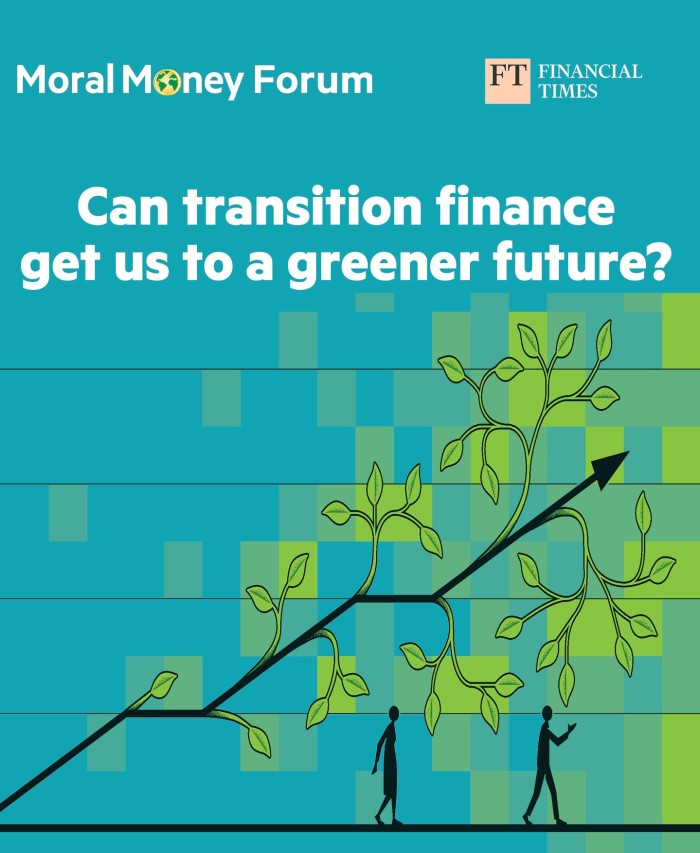Can transition finance get us to a greener future?

To grasp the full scale of the world’s need for transition finance, a good place to start is cement. The key ingredient in concrete, the most widely used man-made substance, cement is produced by a series of complex processes in which raw materials such as limestone and clay are ground to a powder and baked at extremely high temperatures. Carbon dioxide is generated both as a byproduct of the chemical conversion process and through the use of fossil fuels to heat the kilns.
As a result, the cement industry generates more emissions than most large countries. Yet without concrete, much of the world’s infrastructure would be impossible to build. And while the industry is working to cut its carbon footprint, this involves changing cement’s chemical make-up, powering kilns with alternative fuels and recovering and recycling concrete — all of which takes investment.
This is the case for other “hard-to-abate” sectors, such as energy, aviation, construction, steel, shipping, chemicals and mining. For these and other industries, decarbonisation requires expensive moves from the retrofitting of plants and physical infrastructure to changes in the operation of complex supply chains, the adoption of new technologies and a shift to renewable energy sources.
Moral Money Forum

💾 View and download the entire report
🔎 Visit the Moral Money Forum hub for more from this series
It is no surprise, then, that the capital infusions required to decarbonise heavily-emitting industries are eye-wateringly big. Some $13.5tn in investments will be needed in these sectors by 2050, according to research by the World Economic Forum.
This is part of a larger need for expanded capital investment across the global economy to support the low-carbon transition. A 2022 report by McKinsey estimated that annual investment in physical assets will need to rise from $5.7tn to $9.2tn if the world is to meet its net zero goals.
In many developing economies, the focus is more on building out new low-carbon infrastructure than replacing existing high-emitting industrial capacity. But in those nations too, the need for transition finance is stark. India, for example, accounts for more than 7 per cent of global energy-related emissions, according to the International Energy Agency — with nearly a quarter of this coming from industrial plants.
Whether in emerging markets or rich nations, barriers to scaling up transition finance include a lack of accurate data, varying definitions of transition finance, a dearth of offtake agreements and policy uncertainty.
And while decarbonisation will require the managed phaseout of high-emitting assets such as coal-fired power stations, steel mills and cement plants, this will not be easy. Withdrawing finance from dirty assets can simply drive them into less accountable hands. And until clean replacement technologies are up and running, high-emitting assets may continue to require financing.
As a result, there is growing recognition that global decarbonisation will not be achieved simply by building wind farms and solar parks. “You need to green the existing economy and incumbents,” says Ben Caldecott, founding director of Oxford university’s Sustainable Finance Group. “That’s a much bigger challenge and that gets you into murkier water.”
That murkier water holds the risk of greenwashing. Since money is fungible, a bank that is providing financing for, say, an energy company’s wind turbine may simply free up funds for the company to extend the life of a fossil fuel-based asset, perpetuating business-as-usual. When we asked FT Moral Money readers, 61 per cent saw this as a risk.
To prevent their money from being used in this way, investors need to go beyond assessing the climate impact of individual projects such as wind farms or solar parks, says Caldecott. “At the heart of this is that you’re financing the company as a whole for change — you’re not going after specific projects.”
The challenge is that enterprise-wide approaches to decarbonisation vary considerably by sector or geography and involve analysis of everything from emissions reduction to what proportion of revenues is derived from green products or services.
“Transition finance is as complex as it gets,” says Alex Lombos, a lawyer at ClientEarth who leads the commercial banking and transition finance initiatives at the non-profit. “You’re operating at the frontier of the transition and you’re trying to conduct holistic assessments of a business’s transition strategy.”
Yet given the need to attract more capital to decarbonisation, helping investors to navigate this complexity will be essential. “The real question is how do we ensure rigour, credibility and confidence,” says Lombos. “That ultimately is what’s going to head off the risk of a massive misallocation of capital that could put achievement of the Paris Agreement [climate] goals in further jeopardy.”


A journey, not a destination
Anyone looking for a single definition of a transition finance strategy will be disappointed. When we asked FT Moral Money readers what they believed the guiding mission of such a strategy should be, most landed on the financing of either industry decarbonisation generally (37 per cent) or of companies developing the technologies that will enable it (29 per cent).
Technically speaking, definitions of what constitutes a green transition do exist. In the EU, two climate benchmarks come with specific emissions intensity reduction requirements. The Paris-aligned benchmark requires reductions in line with the Paris Agreement and the climate transition benchmark requires reductions of 30 per cent initially and 7 per cent annually.
“That’s the only clear definition that’s technically defined in terms of speed of transition. Everything else is just wording,” says Andreas Hoepner, a professor of operational risk, banking and finance at University College Dublin.
Yet plenty of broader definitions have emerged since the term “transition finance” appeared more than a decade ago. In its guidance for issuers, for example, the International Capital Market Association suggests transition finance “should be directed toward enabling an issuer’s GHG [greenhouse gas] emissions reduction strategy in alignment with the goals of the Paris Agreement”.
Some see the focus as being on finance that enables hard-to-abate sectors such as mining, steel, shipping and aviation to decarbonise. “That’s critically important since the high-emitting sectors are decarbonising much too slowly to meet our collective climate goals,” says Mindy Lubber, president of Ceres, a sustainability-focused network of institutional investors.
At JPMorgan’s Center for Carbon Transition, managing director André Abadie sees transition finance as encompassing everything from clean technologies such as electric vehicles and renewables to nascent technologies needed to facilitate decarbonisation in hard-to-abate sectors such as carbon capture and storage, hydrogen and sustainable aviation fuels. “It’s a broad church, which doesn’t lend itself easily to definition — and that’s part of the struggle,” he says.
Some are less worried about this. “We do agree on what transition finance means at a high level, but you have to leave some room for interpretation jurisdictionally, sectorally and business model wise and it will converge further over time,” says Curtis Ravenel, a senior adviser at the Glasgow Financial Alliance for Net Zero, a coalition of financial institutions.
He adds that the principles-based approach Gfanz uses is similar to that of other frameworks such as the Science Based Targets initiative, the leading global standard setter for corporate climate targets, and the Climate Bonds Initiative, the investor-focused non-profit.
For Adair Turner, the definition of transition finance is simple. “The big story is that we have to reduce investments in the fossil fuel economy, and we’ve got to increase investments in the new zero-carbon economy,” says Turner, chair of the Energy Transitions Commission think-tank and former chair of the UK’s Financial Services Authority. “What we’re talking about in transition finance is how we achieve that.”
Turner’s comment highlights a fundamental characteristic of transition finance: that it is funding for the overall process of decarbonisation in a company or sector. “Transition finance is really about supporting entities to achieve net zero, not simply financing ‘transitional’ activities,” says Oxford university’s Caldecott.
As the OECD puts it in a guidance document it published in 2022, transition finance focuses on “the dynamic process of becoming sustainable” rather than on “a point-in-time assessment of what is already sustainable”.
This, says Abadie, means that transition finance is essentially corporate finance but for a range of activities that need to occur to achieve decarbonisation. “It’s financing the transition rather than transition finance,” he says.
Moreover, creating a new term may not even be that helpful, Abadie adds. “Labelling it as transition finance isn’t necessarily going to open the purse strings,” he says. “Like any economic activity, it needs to make economic sense for clients to decide this is investible.”
Some investors have adapted to the idea of funding a process rather than a specific technology or business model. “We provide finance to companies that are not yet green. We call them improvers,” says Lars Dijkstra, chief investment officer at PGGM, the Dutch pension fund investor.
However, for many asset managers and lenders, investing in an improver is not an easy proposition. While green finance projects tend to have a clear focus — investing in projects like renewable energy installations or green building retrofits — investing in transition finance means investing in enterprise-wide decarbonisation, which may involve a wide range of corporate projects, processes and strategies.
This, says Caldecott, means asking a company about its commitments to decarbonisation, the credibility of its plan to achieve these and the governance and other mechanisms in place to ensure it is meeting its objectives. “And these are difficult questions,” he says.


Transition accountability
Given the lack of clarity around what transition finance entails, the risk of “transition washing” — a version of greenwashing — is very real. “Because there are no established ways of doing this, this holds a lot of people back,” says Nazmeera Moola, chief sustainability officer at London-headquartered asset manager Ninety One.
The difficulty is that measuring the impact of a decarbonisation process versus that of a clean technology investment is far from easy. “The starting point is what quantum of emissions reduction is taking place and whether the pathway for that reduction is Paris-aligned,” says Moola. “But we all know that assessing Paris alignment at this point is more art than science.”
Lack of clarity also presents the risk of what’s known as carbon lock-in. Transition finance might, for example, enable a company to shift from using coal to natural gas as a power source. But while this might reduce its emissions, gas is still a big polluter, generating about 35 per cent of America’s energy-related carbon emissions in 2022, according to the US Energy Information Administration. Yet that new gas infrastructure could remain online for decades.
In the face of these risks, some see financial instruments as powerful accountability tools, particularly in fixed-income markets. When we asked FT Moral Money readers to pick the most effective form of transition finance, 41 per cent selected debt instruments such as transition bonds, sustainability bonds or green bonds.
Of these, University College Dublin’s Hoepner places most value on sustainability-linked bonds, whose contracts can be linked by key performance indicators to the EU’s Paris-aligned and climate transition benchmark standards and can impose penalties on companies that fail to meet those.
“Sustainability-linked bonds have the advantage that they make clear commitments on how to advance on the KPIs,” says Hoepner. “A sustainability-linked bond allows for a contractual penalty — that’s where it gets very interesting.”
Beyond individual financial instruments, one increasingly important tool for investors looking to assess the decarbonisation strategies of their portfolio companies and for advocates pushing for the scaling up of transition finance is the transition plan. This puts the onus on companies to create and publish a credible decarbonisation road map, which essentially turns a challenging proposition — funding a process — into something more measurable and investable.
A transition plan sets out everything from a company’s decarbonisation goals and interim objectives to investment plans and the technologies it intends to use to make it all happen, explains Gireesh Shrimali, head of transition finance research at the Oxford Sustainable Finance Group. “It’s a whole package,” he says.
A key element of this package, says PGGM’s Dijkstra, is a detailed capital expenditure plan setting out how a company is spending its money on decarbonisation. “That’s a good forward-looking metric,” he says. “And that you can measure in an equity or a bond.”
Still, adoption of transition planning has some way to go. In 2023, Sustainalytics found that only 25 per cent of companies had set robust emissions reduction targets and just 8 per cent had credible greenhouse gas performance incentive plans in place.
To help change this, plenty of organisations, from the OECD to the CDP (formerly the Carbon Disclosure Project), have produced transition planning guidance documents, as have some banks and investors.
Barclays has developed two frameworks: one setting out the criteria for the transactions it will count towards its own financing targets as well as one for assessing clients’ transition plans in hard-to-abate sectors, which it uses to engage companies on their progress on decarbonisation.
“We’re trying to move the debate forward,” says Daniel Hanna, Barclays’ group head of sustainable and transition finance. “Because to get transition capital to move at the level we need, which is in the billions and trillions, transition finance models must be credible so that investors are comfortable there’s no transition washing going on.”
At Temasek, Singapore’s state-owned investor, a Climate Transition Readiness Framework is used to assess the maturity of portfolio companies. The framework covers aspects of a business such as board-level oversight, organisational capacity, emissions reduction targets, the alignment of capital allocation with those targets and the accountability measures needed to report on progress in meeting decarbonisation goals.
“We’ve worked with 19 of our portfolio companies, the majority of which are in Singapore, to map out where they are on transition readiness and to identify key gaps where we can do more focused engagement,” says Kyung-Ah Park, head of ESG investment management and managing director of sustainability at Temasek. “We want them to have a much more concrete decarbonisation road map and be more accountable for execution.”
The approach in the Climate Bonds Initiative’s framework is to offer investors and companies what it calls the “Triple A transition plan framework” — ambition, action and accountability. Its guide also presents five “hallmarks” such as time-bound performance targets, third-party verification and publicly available documents that are updated annually. “We need to identify what companies need to do,” says Sean Kidney, the initiative’s chief executive. “It’s forward planning.”
Gfanz produces a range of voluntary guidance documents for financial institutions on how to develop credible transition plans, and for companies on what financial institutions and investors will look for in their transition plan — a tool Ravenel sees as critical in unleashing funding flows for decarbonisation. “Everything you’re doing around transition planning is in the service of scaling transition finance,” he says.
With so many different approaches to creating and assessing transition plans, the UK is working to create a “gold standard” through its Transition Plan Taskforce, which was launched in 2022. And in June, the IFRS Foundation, which is developing the International Sustainability Standards Board reporting standards, announced that it would take responsibility for the TPT’s disclosure framework and guidance.
For Caldecott, enshrining transition plan standards in accounting standards is critical. “You can’t have effective transition finance without credible transition plans,” says Caldecott, who is co-head of the TPT secretariat. “It’s got to be something that can be delivered and is suitably ambitious — but is also accountable.”

The just transition
While most climate protests reflect frustration at the gap between the rhetoric and the progress on decarbonisation, environmental activists are not the only ones making political waves. Anger is also evident in support for politicians who oppose climate action as well as in protests such as those of European farmers, whose grievances include the administrative and cost burdens created by some environmental policies.
All this supports the arguments of those, such as the TPT, who say that people must be placed at the heart of transition planning if the tough measures needed to combat climate change are to be successfully implemented.
Nick Robins sees this as underpinning global decarbonisation, not only from a moral standpoint but also from a practical one. “You can’t separate a purely green process from the wider social context because of the political economy,” says Robins, who heads the Just Transition Finance Lab at the London School of Economics’ Grantham Research Institute on Climate Change.
The lab, which has also produced a guidance document, is working with the UK’s TPT to help banks and investors incorporate social factors into their transition plans and engage with the companies in their portfolios on the risks and opportunities the just transition presents.
For while the shift to a low-carbon economy will generate employment — a net gain of 37mn jobs globally by 2030 according to research conducted in 2018 by New Climate Economy — Robins argues that investment will be needed to ensure that the benefits are felt by all citizens, particularly since transition finance is focused on phasing out hard-to-abate sectors, whose companies are large employers.
“Because climate action is in large part driven by policy, having confidence that the actions policymakers propose will gain support is very important,” says Robins. “And we also know that opponents of climate action will manipulate or manufacture concerns to slow action down.”
Financing will be needed for everything from early retirement programmes to retraining plans and support for new enterprise development in some regions. “But that’s not an overwhelming cost,” he says.
For investors such as banks or pension funds that see decarbonisation as essential to their long-term viability, Robins believes the business case is clear: “A just transition is going to enable a smoother transition.”


A joined-up approach
If money, like water, follows the path of least resistance, removing the obstacles in the path of transition finance will be a priority. “We look at and think deeply about this,” says Seaver Wang, co-director of the climate and energy team at the Breakthrough Institute environmental research centre.
Wang, whose current focus is on the minerals that provide essential components in many clean energy technologies, sets out the obstacles blocking investment in their production.
“These are high-capex projects, and the product is a commodity that’s indistinguishable from one made using dirty methods, so you’re getting no benefit except the positive environmental externality,” he says. Low rates of return and the risk associated with early-stage decarbonisation technologies exacerbate the difficulties, he adds.
Wang’s analysis could be applied to many hard-to-abate sectors. And it is why he argues that public sector funding is an essential part of transition finance.
Of course, public sector funds can be deployed in many ways. More than half of FT Moral Money readers picked government grants and tax incentives as the most effective form of transition finance.
Writing cheques only goes so far, however, and public sector institutions often prefer to use their money as leverage to bring in private investors via blended finance transactions. The World Bank’s International Finance Corporation does this by deploying small amounts of finance to shift the risk-reward profiles of investments that on purely commercial terms would never get off the ground.
This is an important role for public sector financiers, says Anne Simpson, global head of sustainability at asset manager Franklin Templeton. “The private money we’re talking about is not the loose change of the well-heeled — it’s the savings of hard-working people,” she says. “We have to make the returns attractive. And this is where blended finance comes in.”
In emerging markets, which face the biggest challenges around accessing capital for low-carbon investment, policymakers can use financial engineering to make funding more accessible and affordable for emissions reduction projects, argues the Climate Bonds Initiative’s Kidney. “If we want to get things moving quickly [in emerging markets], we need to offer cheaper capital,” he says.
Yet according to some, international finance institutions could be doing more. In a report published last year, the Center for Global Development found that the World Bank’s portfolio of projects lacked standardised reporting on emissions or emissions reduction and contained hundreds of projects tagged climate with only weak links to climate change mitigation or adaptation.
Facing pressure to mobilise more funds for this purpose, World Bank president Ajay Banga has said he will widen the institution’s current mandate. But by his own admission, this could be tough. Last September, he likened the bank’s contribution to the $3tn in climate financing US Treasury secretary Janet Yellen has said the world needs to spend annually to “a pimple on a dimple on an ant’s left cheek”.

Beyond warm words
In setting out the global decarbonisation challenge, Franklin Templeton’s Simpson does not mince her words. “For all the talk, the warm words and the commitments, the world economy is still 80 per cent dependent on fossil fuels,” she says. “We’ve had this once-only-offer form of energy storage and 300 years ago, we worked out how to tap into it. Now we’ve given ourselves 30 years to find all the new stuff that’s needed for the transition.”
Put like that, it could be easy to lose hope that sufficient progress can be made in time. Yet some point out that advances are being made. “There is an incredible amount of good news here,” says Kidney, explaining that in his discussions with governments and companies, the question is not whether to decarbonise, but how. “That’s a very different conversation from five years ago.”
Yet as Simpson has pointed out, in the end money talks and for the investment community to take up transition finance at scale, confidence in the potential financial returns must be part of the picture.
Evidence of this is starting to emerge. For example, research by data company MSCI found that in the seven-and-a-half years to March 2023, companies in emissions-heavy sectors with a higher share of revenue from alternative energy, energy efficiency and green buildings had faster earnings growth than their sector peers.
For Ninety One’s Moola, the investment case is clear. “We believe that as the focus on transition continues to grow this will be a tailwind for returns,” she says. “So not including it as part of a general climate allocation would be a missed investment opportunity.”
Yet while investors appear to recognise the opportunities for profit, few are pursuing them. In a 2022 survey by Ninety One, roughly half of the 300 asset owners and advisers it polled saw transition finance as a major commercial opportunity. But only 35 per cent said their organisation was likely to make transition finance investments in the next 12 months.
However, Simpson has some advice for investors. “We’ve got to not get in a froth about everything, everywhere, all at once,” she says. “Thinking about the discipline of risk and return gets you a long way down the road to telling you what you need to do.”
#transition #finance #greener #future




